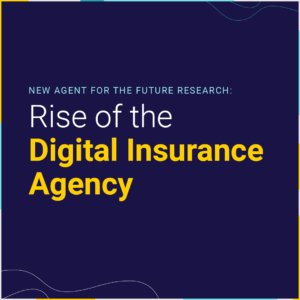With restrictions on in-person business in 2020, many agencies leaned on digital forms of marketing and communication to reach current and potential customers.
Agencies adopted new digital capabilities to facilitate remote work and meet customer needs.
As agencies returned to in-person ways of doing business, the adoption of new tools slowed and investing in digital became less of a priority for agencies.
In late 2020, 58% of agencies said that adding new digital capabilities was part of their five-year growth plans. In late 2021, that number dropped to 47%, about the same as in 2017.
For many years, there has been a broad spectrum of digital adoption among independent insurance agencies – from agencies that use few digital tools and prefer traditional ways of doing business to those that operate completely digitally.
To better understand variation in digital adoption, we created the Agent for the Future Index. The index scores low and high digital adopters on a 10-point scale based on the average number and complexity of digital tools each group used.
The Index is meant to show changes in digital adoption over time, but between 2020 and 2021, the index for high and low adopters barely moved. While the use of some tools declined in agencies overall, high and low digital adopters were using about the same number of digital tools in 2021 as they were in 2020.
Agent for the Future Index
2020
2021
2020
2021
The digital tools that dropped in use
For many of the digital capabilities analyzed in our survey, agency use stayed roughly the same between 2020 and 2021.
Some tools are simply table stakes for doing business in the modern era. For example, more than 90% of agencies use email and e-signature, and roughly 80% use texting and online quoting.
Others, such as automated communications, voice over IP and agency self-service portals, are continuing to be used by roughly half of the agencies we surveyed.
However, adoption of a few tools notably decreased between 2020 and 2021. These included complex tools, such as search engine optimization, live online chat and Google ads.
Use of social media and digital marketing also declined among agencies. And while the same percentage of agencies reported having social media accounts, fewer were using paid social ads.
Digital tools that declined in use among agencies
Tracking marketing tactics
Our research also found that many agencies aren’t tracking which digital tools drive business growth. Of survey respondents who indicated they contribute to agency marketing activities, less than half said their agencies track the source of new business from digital marketing. Those whose agencies do track their digital marketing efforts identified the agency Facebook account, email marketing and unpaid SEO activities as the most effective ways of generating new business.
This suggests that agencies may be missing out on some digital opportunities that could help drive new business. Tracking the impact of digital marketing efforts can help agencies decide where to focus and invest for the most impact.
As we’ll explore in the next section, agencies focused on growth are more likely to use digital tools, and more likely to track their digital marketing activities.

